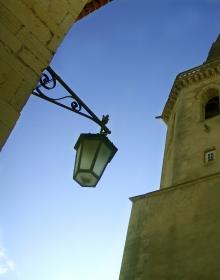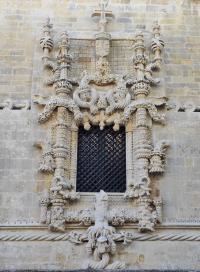- HOME
- MONUMENT
- Convent of Christ
- History
- Architecture
- Personalities
- King Afonso Henriques
- D. Gualdim Pais
- King Dinis
- King John I
- D. Lopo Dias de Sousa
- King Duarte
- Prince D. Henrique (Henry
- King John II (1455 - 1495
- King Manuel I (1469 - 152
- Diogo de Arruda
- João de Castilho
- Jorge Afonso
- Olivier de Gand
- King John III (1502 - 155
- Diogo de Torralva
- Friar Anthony of Lisbon
- Baltazar de Faria
- Filipe Terzi
- Philippine Dinasty
- King Philip II of Spain
- King John IV
- Domingos Serrão
- Queen Mary II
- Prince Fernando
- Costa Cabral
- Artisans and Artists
- Intangible Heritage
- Related Heritage
- Glossary
- VISIT OUR MONUMENT
- HERITAGE LEARNING
- TOMAR
- MONASTERIES ROUTE

Town of Tomar
Humans settled in the area long before this (some 30,000 years ago), thanks to the excellent climate, abundant water, ease of river travel and the fertile soils. As proof of the successive civilisations and settlements in the area, we have today important finds of tools and utensils, caves, dolmens, settlements, a number of gravestones, coins, some sculptures, utilitarian items, the legend of Saint Irene, place names, watering wheels and dams.
The Romans founded the town of Sellium, giving it an orthogonal plan resulting from the perpendicularity of the characteristic cardo and decumanus axes that determined the urbanistic organisation of Roman settlements. In addition to the ruins of the Sellium Forum, the excavation work carried out (around 1980) in what is now Alameda 1 de Março unearthed further vestiges of houses from this period.
By the mid-7th century there were already convents and monasteries in the area. The Visigothic period legend of the martyr Saint Irene (Santa Iria) dates from this period.
However, the name Tomar is derived from the Moors, who occupied the area from 712 AD onwards, calling it Tamaramá, meaning sweet waters.
The name Thomar appeared with the construction of the castle (1 March 1160) and the town below it by the Order of the Temple. The construction work lasted for 44 years.
In the 14th century, with Henry the Navigator at the head of the Order of Christ, the town of Tomar experienced significant growth. The Várzea Pequena area was urbanised, applying a daring orthogonal layout, with development running parallel to the Corredoura (Rua Serpa Pinto) and perpendicular to the river.
King Manuel I granted the town a New Charter in 1510. Aalso in the 16th century, the architects and artists Domingos Vieira Serrão, João de Castilho, Olivier de Gand, Fernando Muñoz, Diogo de Arruda, Gregório Lopes, João de Ruão and Diogo de Torralva made Tomar an important centre for the arts.
In the Philippine period the Spanish monarchs also invested in Tomar, with works on the Convent's Main Cloister and Aqueduct, as well as the creation of the Santa Iria Fair, which still exists today.
Between the mid-17th century and end of the 19th century Tomar underwent major industrial development: industries included the Prado factory, Matrena glass manufacture, millinery, spinning, weaving and papermaking.
Following a visit by Queen Maria II, Tomar was given the status of city in 1844, making it the first city in the District of Santarém.
Silva Magalhães, the first Tomar photographer, opened his "Typographia & Photographia" in 1862. He left behind a fabulous collection of photographs of views of Tomar, portraits, traditional costumes, professions and scenes from everyday life. Cinema first emerged in Tomar six years after its invention (17.11.1901) at the Teatro Nabantino, which gave way to a new building in 1923: the Cine-Teatro Paraíso. The town's first newspaper arrived in 1879 in the form of the weekly "A Emancipação", with Angelina Vidal as its editor-in-chief. After Lisbon, Porto, Elvas and Vila Real, in 1901 Tomar received electricity, which was generated in the power plant installed in the town's old mill complex.
Manuel Mendes Godinho became an omnipresent figure in the economic development of Tomar in the 20th century. From 1912 onwards he built up an industrial empire (milling, ceramics, cattle feed, oil presses and chipboard manufacture) that spanned the whole century and also led to the establishment of a bank.
In the 1950s (on 21.01.1951 to be precise), the Castelo do Bode hydro-electric dam was opened. It was to be the largest such dam in the country for the following fifty years.
In 1950 João dos Santos Simões revived the Festa dos Tabuleiros (Festival of the Trays), giving it national and international projection.
The 20th century reflected the intensive cultural activity that was always part of life in Tomar, examples being the establishment of the Society of Friends of the Order of Christ in 1918 and the Initiative and Tourism Commission, both of which are involved in the protection and dissemination of the town's heritage.
In 1983 UNESCO classified the Templar Castle/Convent of Christ complex as a World Heritage Site and in the 1990s the first steps were taken towards the rehabilitation and consolidation to Tomar's historic centre.
The plan of the mediaeval town (now the historic centre) has an orthogonal layout attributed to Henry the Navigator. The centre, with the Town Hall and Main Church (Igreja Matriz), is the Praça da República, around which the town's main public and religious buildings are located. To the south is the synagogue, the former Misericórdia Hospital, the Convent of São Francisco (St. Francis) and the town's old main square; to the north are the chapels of São Gregório (St. Gregory) and Our Lady of Piety and the former Convent of the Annunciation; to the west are the Castle hill, the Chapel of Nossa Senhora da Conceição (Our Lady of the Conception) and the Convent of Christ; to the east is the medieval bridge, the former town mills, the Convent of Santa Iria (St. Irene) and the Church of Santa Maria do Olival.
Foral de Tomar

“O foral outorgado a Tomar, em 1161, não obstante se ter passado já meio século, é de entre todos o que mais fielmente decalca o foral de Coimbra, de 1111. As pequenas diferenças existentes entre os dois resultam do esmero literário, quiçá da evolução sem (...)
Click here to find out more
Tomar Today

As bordering councils, it has Ferreira do Zêzere to the northeast, Abrantes to the east, Vila Nova da Barquinha to the south, Torres Novas to the West / Southwest and Ourém to the Northwest. (...)
Click here to find out more
SERVICES - ACTIVITIES




